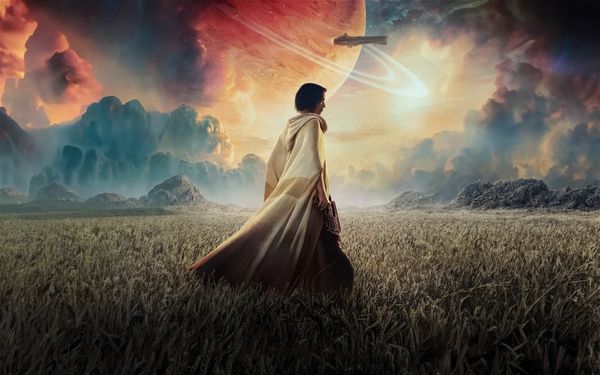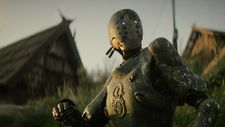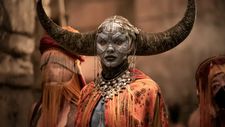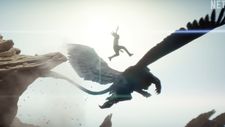 |
| Sofia Boutella in Rebel Moon |
The kind of free for all space opera action blockbuster which might not score with the critics but will easily entertain viewers during the holiday season, Zack Snyder’s Rebel Moon: Part One – A Child Of Fire is big and bold and orange and teal and full of fighting and explosions. A sort of updated Battle Beyond The Stars (with debts to The Magnificent Seven and Seven Samurai, it sees a mysterious outlaw sparked into action by threats to the space Viking village (yes, really) where she has been hiding out. Determined to bring down the galactic power which keeps everyone else cowed, she travels from world to world in search of heroes to join her on her quest.
 |
| Rebel Moon: Part One – A Child Of Fire |
Naturally, a journey like this provides a lot of opportunities to explore new environments, and though the broad strokes of the film are gleefully derivative, there’s a lot of nice work around the edges. From creature design to space battles, it’s this that really gives the film its appeal, and that has seen it shortlisted for a VFX Oscar. Shortly after the Oscar announcement, I had the chance to catch up with VFX lead Marcus Taormina and ask him a couple of questions about how it all came together.
“I think the thing that's great about Zack is he has that visual style, he has that distinctive characteristic, but he also lets us kind of rip,” he told me. “So he usually storyboards the majority of the film. We'll go out and we'll basically shoot his boards on occasion, just as shooting goes, but there's an organic quality to it, so every once in a while, he'll go, ‘Oh, it would be cool if we look this way and do a big, huge scopey shot.’ So I'm like, ‘Yeah, let's do it.’ But again, the thing that's really good about him is he lets you riff, and he kind of lets all departments riff a little bit and take it upon themselves to make it their own.
“Obviously, there's certain things that are very Zack Snyder, like the slow mo, but I enjoyed taking the opportunity to say ‘Okay, this is your style, but we're going to amplify it by adding certain details to it.’ We really enjoyed doing that, and I think it turned out really great. And I’ve got to applaud Zack for just letting us go. And not only me as a creative lead, as a visual effects supervisor, but all the facilities and all the artists were right behind it, too.”
 |
| Rebel Moon: Part One – A Child Of Fire |
He worked on the project for two and a half years, he explains, and he’s already started work on its sequel, which is expected to take a similar amount of time. He wanted to give each world a distinct appearance and, again felt that he and his team had great support from Snyder in doing so. He also loved working with star Sofia Boutella, who plays heroine Kora, because she took a real interest in the production process and made the process of taking the actors through green screen scenarios much easier.
These days, I note, video games increasingly have effects generated in the same sort of way. How did he go about creating something which would still have that cinematic impact and make people want to see Rebel Moon on the biggest screen they can?
“Oh, man,” he says. “Lots of time, lots of effort, lots of care, lots of details. I'm obsessive about Zack. Zack will get in there sometimes and I'll be like, ‘This is the shot. I'm not ready with it yet.’ And I'll show him the shot and he’ll be like, ‘It looks really good.’ I'm like, ‘But I'm not done with it yet. I want to do this, and this.’ And he's like, ‘Great! Go do it again.’
“A great filmmaker will allow that to happen, and it's the tiny details to me that really matter, and we kind of have to push the technology every single time. I think a great example is when we started out in this film. It's like, ‘Okay, what's our palette? What do we want it to look like?’ I said ‘We want it to feel gritty and dirty.’ And so what does that mean?
 |
| Rebel Moon: Part One – A Child Of Fire |
“Okay, well, we absolutely love Dune's dust, and it's not a disrespect to them. It's like, we love that, but we want to make it better. So how do we make it better? And so we have to push our resources to the limits and get this really dirty, gritty feel while also going ‘You have to match this,’ because we did practical dust plates with a helicopter for some of the first drop ship landing, and then you have to meld it together and just create that – I want to say cinematic – realistic look. And again, I think it’s just about grounding the cameras in the surrounding footage. And also, the optics that get in the next click. I know some people don't love the shallow depth of field, but it's a creative choice.
“I don't want to go and have all this practical footage of our cast shot, and then in between there, do a crisp CG shot. It won't work. People are going to be like, ‘That's digital.’ So I want to make sure there's subtlety but a lot of detail to each of our shots.”
Rebel Moon: Part One – A Child Of Fire has a limited cinema release and is available to watch on Netflix worldwide.





















